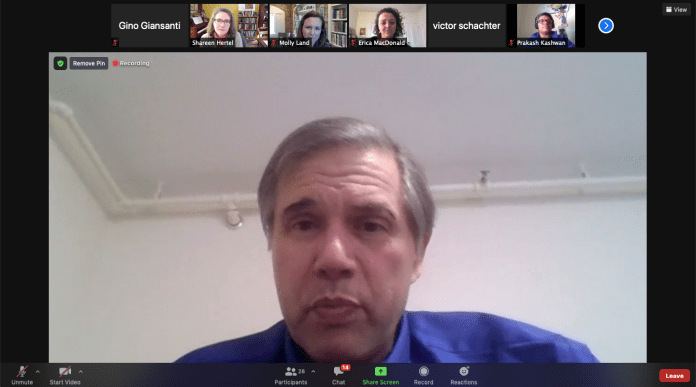Dr. Michael Stein attended a lunchtime seminar with professors and students on Friday afternoon that dealt with disability and employment. The Organization for Economic Co-operation and Development carried out a study in the late 2000s that found that only around 40% of people with disabilities were employed, compared with an employment rate of around 75% for people without disabilities. Photo courtesy of the author.
There are more than a billion people with disabilities worldwide, 80% of whom live in developing countries, are excluded from society and deny basic human rights. Although human rights are a broad field, economic and social rights remain as important to a person’s well-being as their civil and political rights.
In a lunchtime seminar entitled “Disability and Social Rights”, the Human Rights Institute, in collaboration with the Research Group on Economic and Social Rights and the Research Program on Global Health and Human Rights, received Professor Michael Ashley Stein. Stein is co-founder and director of the Harvard Law School project for the disabled and has been a visiting professor at Harvard Law School since 2005. In Friday’s discussion, Stein addressed disability and employment and explained the violation of the right to work People with disabilities is a harmful reality of our world today that needs to be addressed.
“People with disabilities have experienced high levels of social exclusion in all areas of society in the past,” said Stein. “Employment inequality is particularly damaging because, as we all know, a livelihood is directly necessary to prevent or reduce poverty, as well as the poverty of several generations, and income provides the opportunity to access a wide range of human rights receive . ”
The Organization for Economic Co-operation and Development carried out a study in the late 2000s that found that only around 40% of people with disabilities were employed, compared with an employment rate of around 75% for people without disabilities.
“Here in the US,” said Stein. “We have an unemployment rate between 75% and 80% [for persons with disabilities] For at least five or six decades we in the United States have failed traumatically in this regard. ”
We are between 75% and 80% unemployment [for persons with disabilities] For at least five or six decades we in the United States have failed traumatically in this regard.
Professor Michael Ashley Stein, Co-Founder and Executive Director of the Harvard Law School Project on Disability
Not only are people with disabilities hired at lower rates than people without disabilities, but they are paid significantly less than their peers for the same job and have greater difficulty advancing their careers.
“In addition, employers tend to overestimate the productivity of workers without disabilities, underestimate the productivity of workers with disabilities, overestimate the cost of reasonable accommodation, and be unaware of public policies and programs that address potential challenges . ”
This mix, Stein said, makes employers less inclined to hire people with disabilities and pay them less at the same rate as their peers without disabilities, which ultimately prevents workers with disabilities from even entering the labor market.
All the more remarkable in the midst of the COVID-19 pandemic, the right and the ability to work are of crucial importance, not only from an economic point of view, to secure a livelihood but also to make workers feel dignified and perform well.
“[The right to work is] internationally recognized as one of the most basic social rights, ”said Stein. “When freely chosen, it contributes to personal development, a sense of identity and a sense of fulfillment. In addition, the lack of meaningful employment could severely limit a person’s ability to participate fully in social, political and economic life. ”
Stein notes that the future of the labor market for people with disabilities is particularly alarming, as artificial intelligence is predicted to replace many current jobs, along with the fact that the world population is expected to grow by another billion people in the coming Decades.
As a means of building a more inclusive society, Stein described the need to destigmatize and dismantle the social construct of special needs. Too often people with disabilities are seen as needy or unable to complete tasks of the same quality as people without disabilities. Too often the idea of shelter for people with disabilities is seen as a burden on institutions and organizations to grapple with, while there is a clear capacity to destigmatize shelter. Take, for example, the “Talk to Text” function on smartphones. While its function is to help people with disabilities, it is presented in a way that is accessible to all users without excluding or excluding the people for whom it is intended. With such social implementations, we can work towards a more inclusive and fairer future.

